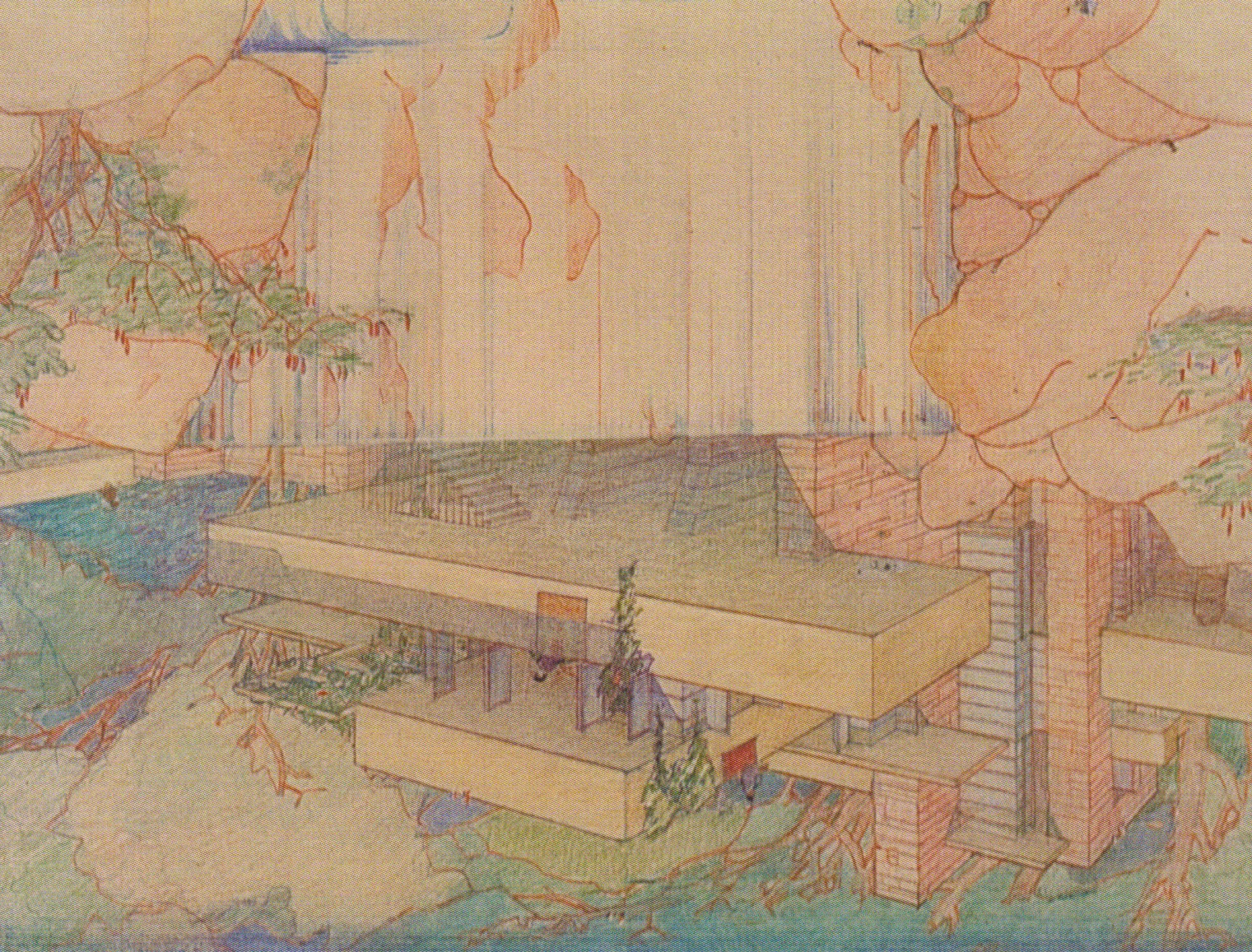Between ruins and landscapes
Heterotopic poetics in the architecture of Frank Lloyd Wright
DOI:
https://doi.org/10.18861/ania.2025.15.2.4194Keywords:
heterotopia, Michel Foucault, Frank Lloyd Wright, Fallingwater house, space, architecture, archaeological-hermeneutic methodAbstract
We propose an analysis of Frank Lloyd Wright's architecture, particularly the 1936 Fallingwater House, from the notion of heterotopia. This concept was introduced by French philosopher Michel Foucault, who defined it as other places that function as counterspaces that question the usual places in the city. This conceptual tool has been extremely useful for architectural theory and criticism, as it makes decentered discourses visible, marginalizing those other histories that remain outside the dominant architectural discourse. In particular, we are concerned with the heterotopias of Mayan and Japanese cultures, which will inform the spatial conception of our case study. Their poetics allow us to consider the American architect within a decentralized aesthetic of the modern movement that strongly took hold in the 20th century. The conclusion is that conceptual shifts between philosophy and architecture help to clarify critical positions by interrogating the other. It is concluded that conceptual shifts in the concept of heterotopia challenge critical positions in architecture by questioning otherness in space.
Downloads
References
Aljanabi, H. y Al-Ani, M. (2023). Post reality and virtual reality in heterotopic and heterochronic spaces. ISVS e-journal, 10(5), 185-192. <https://www.researchgate.net/profile/Mohammed-Al-Ani-3/publication/372189303_Post_Reality_and_Virtual_Reality_in_Heterotopic_and_Heterochronic_Spaces/links/64a85a98b9ed6874a50417c0/Post-Reality-and-Virtual-Reality-in-Heterotopic-and-Heterochronic-Spaces.pdf>.
Alofsin, A. (1993). Frank Lloyd Wright. The lost years, 1910-2922. A study of influence. The University of Chicago Press.
Alzamán, D. (2018). Frank Lloyd Wright. La estampa japonesa. Sans Soleil Ediciones.
Bantim, N. (2025). From entrepreneurialism to utopias: Heterotopic appropriation of Rio de Janeiro after mega-events. Cadernos Metrópole, 27(63). <https://doi.org/10.1590/2236-9996.2025-6363788-en>.
Bracken, G. (2024). Is it or isn’t it? Six principles for identifying a heterotopia (1984). Atlantis, 34(2), 8-11.
Brooks, B. (1988). Frank Lloyd Wright in the realm of ideas. Southern Illinois University Press.
Brooks, B. (1996). Frank Lloyd Wright drawings. Harry N. Abrams.
Brooks, B. (2010). Frank Lloyd Wright (1917-1942), The complete works. Taschen.
Brooks, B. (2011). Frank Lloyd Wright designs: The sketches, plans, and drawings. Rizzoli.
Buğra, S. y Şentürer, A. (2024). Evaluating public spaces through the concept of other: A heterotopic approach. Journal of Design for Resilience in Architecture and Planning, 5(1), 01-17. <https://doi.org/10.47818/DRArch.2024.v5i1116>.
Conrad, A. (2005). “Upward on wings”: Frank Lloyd Wright’s Guggenheim as the disruption of the museum space [tesis de maestría, The State University of New York at Buffalo].
D’Agostino, A., Poli, G. y Vannelli, G. (2023). A paradigmatic shift from heterotopia to hypertopia. New values to reinterpret burial space design and the relationship between cemeteries and cities. Bollettino Del Centro Calza Bini, 23(1), 157-176. <https://doi.org/10.6093/2284-4732/10481>.
De Long, D., Spirn, A., Peatross, C. y Sweeney, R. (1996). Frank Lloyd Wright: Designs for an American landscape, 1922-1932. Harry N. Abrams.
Deleuze, G. (1987). Foucault. Paidós.
Dickinson, K. (2024, October). Not your typical oriental carpet: Collage as heterotopia in Nevin Aladağ’s social fabric series. Colloquia Germanica, 57(4), 437-462. <https://doi.org/10.24053/CG-2024-0021>.
Duncan, P. (2019). Alfred Hitchcock. Taschen.
Emmer, R. (2022). Living between the lines: How Japanese crafts taught Frank Lloyd Wright, Adolf Loos, and Eileen Gray to see modern domestic space [tesis doctoral, The University of New Mexico]. <https://www.proquest.com/dissertations-theses/living-between-lines-how-japanese-crafts-taught/docview/29069448>.
Foucault, M. (1984). Of other spaces: Utopias and heterotopias. Masachusetts Institute of Technology. <https://web.mit.edu/allanmc/www/foucault1.pdf>.
Foucault, M. (2008). Topologías. Fractal, 48. Ediciones de Educación y Cultura.
Fullaondo, J. y Moñoz, M. (1992). Zevi. Kain Editorial.
García, M. (2017). Cineastas y arquitectos. Libros de la Catarata y Fundación Arquía.
Hölling, H. (2021). Keeping time: On museum, temporality and heterotopia. ArtMatters: International Journal for Technical Art History, (1), 1-21. <https://discovery.ucl.ac.uk/id/eprint/10131372/>.
Iglesias, J. y Jiménez, J. (2025). La autobiografía en la formación de docentes de Historia de la Arquitectura: Una ruta eficaz hacia los conceptos de espacio. Arquitectura +, 10(19), 2-16. <https://doi.org/10.5377/arquitectura.v10i19.20515>.
Jacobs, S. (2007). The wrong house: The architecture of Alfred Hitchcock. Nai010 publishers.
Korkut, E. y Surer, E. (2024). Developing a framework for heterotopias as discursive playgrounds: A comparative analysis of non-immersive and immersive technologies. Virtual Reality, 28(16). <https://doi.org/10.1007/s10055-023-00905-w>.
Meech, J. (2001). Frank Lloyd Wright and the art of Japan. The architect´s other passion. Harry N. Abrams Inc.
Morey, M. (2014). Escritos sobre Foucault. Sexto Piso.
Nute, K. (1993). Frank Lloyd Wright and Japan: The role of traditional Japanese art and architecture in the work of Frank Lloyd Wright. Van Nostrand Reinhold.
Salazar, B., Lunagómez, E. y Vázquez, L. A. (2024). Un cuestionamiento crítico sobre la capacidad de la arquitectura como agente de cambio. Anales de Investigación en Arquitectura, 14(2). <https://doi.org/10.18861/ania.2024.14.2.3909>.
Shamma, N. y Keynoush, S. (2023). Prison as a mirror: The reflection of the prison concept & the re-evaluation of the built environment. 6th Conference of Contemporary Affairs in Architecture and Urbanism, 6(1), 273–293. <http://dx.doi.org/10.38027/ICCAUA2023EN4122>.
Tafuri, M. (1984) La esfera y el laberinto. Vanguardias y arquitectura de Piranesi a los años setenta. Gustavo Gilli.
Valdez, L. y Casillas, A. (2023). Apego al lugar en espacios heterotópicos: Reflexión teórica en la ciudad postmoderna. Pensum, 9(11), 126-145. <https://doi.org/10.59047/2469.0724.v9.n11.41082>.
Wright, F. (1978). El futuro de la arquitectura. Poseidón.
Wright, F. (1998). Frank Lloyd Wright. Autobiografía 1867 [1944]. Croquis.
Wright’s Japan (s/f). Frank Lloyd Wright and Japan: a timeline. Wright’s Japan. <https://www.wrightsjapan1905.org/japan-timeline/>.
Zevi, B. (1995). Frank Lloyd Wright. Gustavo Gili.
Zevi, B. (2000). Dopo 5000 Anni: La Rivoluzione. Lotus Internacional.
Zhu, J. (2024). Ricerche sullo spazio pubblico ispirate all’eterotopia: una proposta di discussione. Territory of Research on Settlements and Environment, 32(1), 123-136. <https://doi.org/10.6093/2281-4574/11014>.

Downloads
Published
How to Cite
Issue
Section
License
Copyright (c) 2025 Julio Jesús Jiménez Sarabia

This work is licensed under a Creative Commons Attribution 4.0 International License.
The journal and its contents are licensed under the Creative Commons - Attribution 4.0 International License (CC BY 4.0). It is possible to copy, communicate and publicly distribute its content as long as the individual authors and the name of this publication are cited, as well as the publishing institution (Universidad ORT Uruguay).

